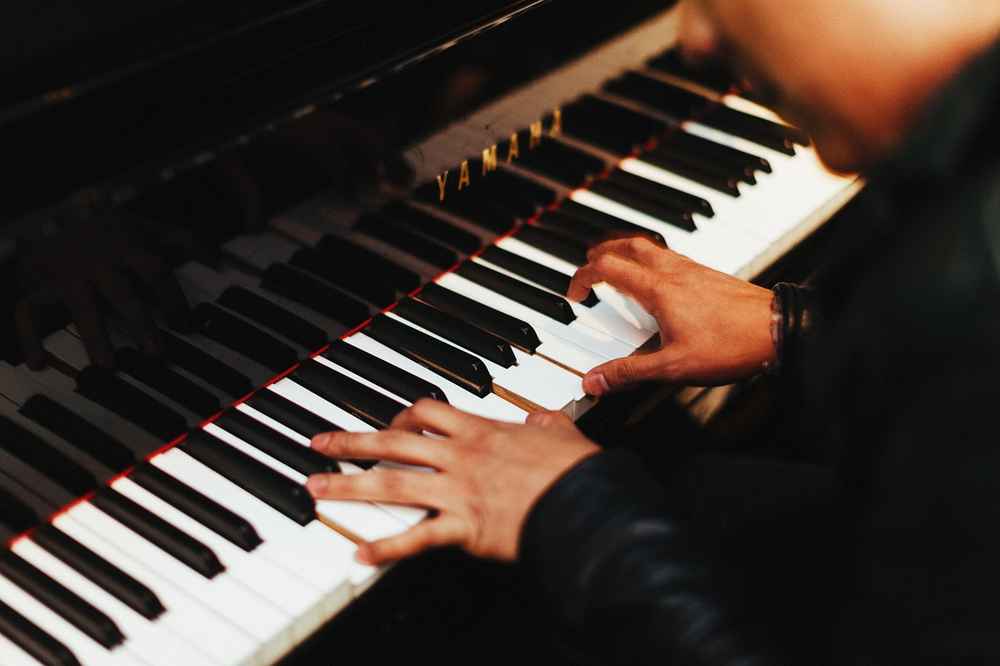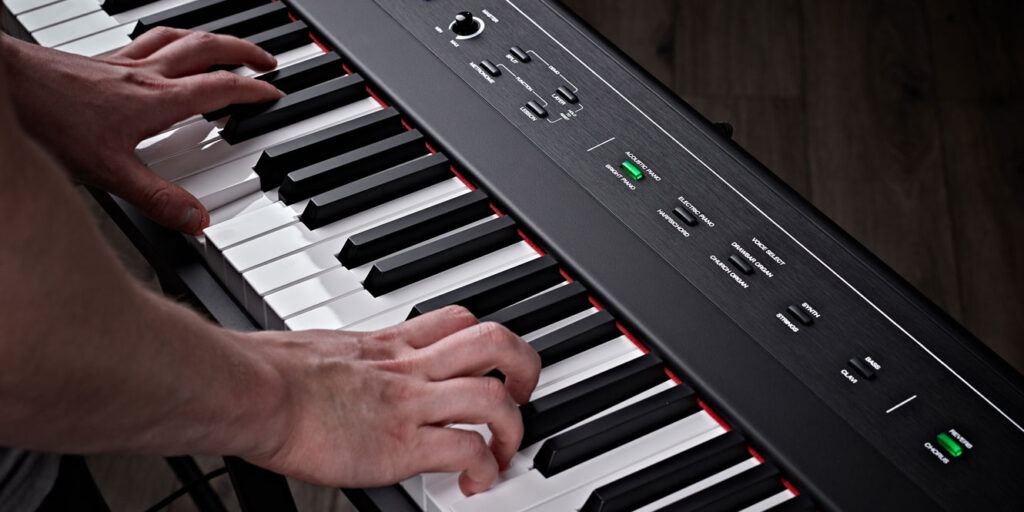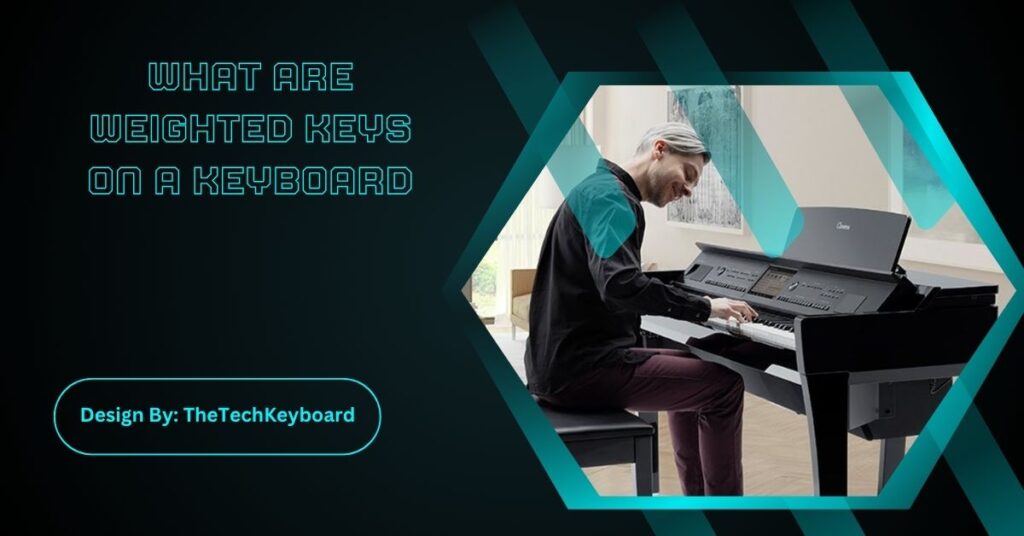Weighted keys mimic the feel of acoustic piano keys by adding resistance. They improve technique, finger strength, and dynamic control, making them ideal for learners and musicians seeking realistic piano experiences on digital keyboards.
When choosing a piano or digital keyboard, you’ll likely encounter the term “weighted keys.” But what are weighted keys on a keyboard? Why do they matter? And should you buy a keyboard with them?
Whether you’re a beginner looking to learn piano or a seasoned musician seeking a more authentic playing experience, understanding weighted keys is essential for making the right choice. In this article, we’ll explore what weighted keys are, how they work, their different types, and whether they’re worth the investment.
What Are Weighted Keys on a Keyboard?
Weighted keys refer to keyboard keys that are designed to mimic the resistance and feel of an acoustic piano. When you press a key, it doesn’t go down too lightly or too fast—it has a certain amount of force or “weight,” just like a traditional piano hammer mechanism.
This added resistance helps build finger strength, improve control, and make the transition from digital keyboards to acoustic pianos smoother for learners.
Why Weighted Keys Matter

Here’s why weighted keys are important:
- 🎵 Realistic playing feel
- 💪 Better technique and finger strength
- 🧠 Muscle memory development for real piano
- 🎶 Expressive dynamics with soft and hard playing
- 🎹 Easier transition to acoustic piano
If your goal is to eventually play a grand or upright piano, weighted keys are a must.
Types of Key Weighting Explained
There are different levels and styles of key weighting. Not all keyboards use the same system, so it’s essential to know the difference.
1. Unweighted Keys (Synth-Style)
- Lightest feel
- No resistance
- Found in budget keyboards or synthesizers
- Not ideal for piano learners
- Great for fast playing, electronic music, or portability
2. Semi-Weighted Keys
- Slight resistance using spring-loaded mechanism
- More feedback than unweighted
- Found in beginner keyboards
- Good compromise for casual players
3. Fully Weighted Keys
- Mimic acoustic piano resistance
- Even force across the entire keyboard
- Better dynamics and control
- Found in digital pianos and high-end keyboards
4. Graded Hammer Action (GHA) / Scaled Hammer Action
- Most realistic feel
- Lower notes (left side) are heavier
- Higher notes (right side) are lighter
- Mimics the natural hammer behavior in acoustic pianos
- Ideal for serious learners or advanced players
Weighted vs. Unweighted: Quick Comparison
| Feature | Unweighted Keys | Weighted Keys |
| Resistance | Very light | Moderate to high |
| Feel | Like a computer keyboard | Like an acoustic piano |
| Technique building | Low | High |
| Suitable for beginners | Not recommended | Highly recommended |
| Cost | Budget-friendly | More expensive |
How Weighted Keys Work Mechanically
In acoustic pianos, hammers strike the strings to produce sound, requiring varying pressure to play soft or loud notes.
Digital keyboards with weighted keys attempt to recreate this by:
- Using springs or metal counterweights
- Incorporating graded pressure sensors
- Simulating hammer movement through sensors and feedback systems
Some high-end digital pianos even feature wooden keys with triple-sensor technology for ultra-realistic response.
Are Weighted Keys Good for Beginners?
Yes! In fact, weighted keys are highly recommended for beginners because:
- They help build finger strength and dexterity
- They encourage correct hand positioning
- They promote expressive dynamics from the start
- They make it easier to switch to real pianos later on
If you’re serious about learning piano, avoid unweighted keyboards and go for fully weighted or graded hammer action keyboards.
Weighted Keys and Muscle Memory
Developing muscle memory is critical for pianists. If you practice on unweighted keys, your fingers might “float” or rely on incorrect motion. This leads to trouble when switching to a real piano.
Weighted keys simulate the effort and motion patterns of real piano playing, giving you:
- Accurate hand training
- Improved rhythm and timing
- Better control over dynamics (forte vs piano)
How to Know If a Keyboard Has Weighted Keys?
When shopping for a keyboard, check the product description for phrases like:
- “Weighted keys”
- “Graded hammer action”
- “Hammer action keys”
- “Touch-sensitive” (though not always weighted)
If in doubt, look at the model’s spec sheet or reviews.
Weighted Keys in Digital Pianos vs. MIDI Controllers
✅ Digital Pianos
- Designed for piano-like feel
- Include speakers and onboard sounds
- Have weighted or graded hammer action keys
- Ideal for learners and performers
✅ MIDI Controllers
- No built-in sounds (require software)
- Used for music production
- Some come with semi-weighted or fully weighted keys
- Great for producers, not always ideal for piano learners
Top Keyboards with Weighted Keys (2025 Recommendations)
🎹 Yamaha P-125a
- Graded hammer action
- Realistic piano tones
- Affordable and portable
🎹 Roland FP-30X
- SuperNATURAL sound engine
- Fully weighted keys
- Great for practice and gigs
🎹 Casio PX-S1100
- Slim design
- Smart Scaled Hammer Action
- Excellent value for its price
🎹 Kawai ES120
- Ivory-touch keys
- Responsive Hammer Compact II action
- Warm piano tone and premium features
Do Weighted Keys Increase the Price?

Yes, keyboards with weighted keys tend to be more expensive, but they’re worth the investment if you:
- Plan to learn seriously
- Want a realistic playing experience
- Aim to transition to acoustic piano
Expect to spend $400–$1,200 for quality weighted-key models.
Weighted Keys and Learning Apps
Weighted keyboards are often compatible with learning apps like:
- Simply Piano
- Flowkey
- Yousician
- Piano Marvel
These apps track your dynamics, timing, and hand movement—features that only work well with responsive, touch-sensitive, and weighted keys.
Common Mistakes When Buying a Keyboard
- Buying an unweighted keyboard to “try it out”
- Ignoring touch sensitivity and key action
- Choosing fewer than 88 keys (if aiming for piano skill)
- Prioritizing features over feel
- Not testing the keyboard in-store or watching demo videos
FAQs:
1. Why are weighted keys important for piano practice?
Weighted keys help replicate the feel of acoustic pianos, allowing students to develop proper finger strength, control, and dynamics. This prepares them for transitioning to real pianos and ensures better overall playing technique.
2. Are semi-weighted and fully weighted keys the same?
No. Semi-weighted keys offer moderate resistance using springs, while fully weighted keys closely simulate acoustic piano hammer action. Fully weighted keys are better for advanced learning, while semi-weighted suits beginners or casual players.
3. Do weighted keys affect learning speed for beginners?
Yes. Weighted keys help beginners build accurate muscle memory and improve dynamics from the start. Although they may feel harder to press initially, they promote faster long-term learning and a smoother transition to acoustic pianos.
4. Are weighted keys necessary for music production?
Not always. Music producers often use semi-weighted or unweighted MIDI controllers for electronic music. However, if piano realism is needed in recordings, fully weighted keys provide better expressive control and authenticity in performance.
5. Do all weighted keyboards have 88 keys?
No. While many weighted keyboards mimic full-size pianos with 88 keys, some models with 61 or 76 keys also include weighted action. Choose based on space, budget, and your playing goals.
Conclusion
Weighted keys give digital keyboards a piano-like feel, enhancing realism, technique, and musical expression. They are ideal for students aiming to transition to acoustic pianos and musicians seeking better control over dynamics. Beginners benefit from starting on weighted keys to develop correct habits, while professionals appreciate their authentic response during performances. Although more expensive, investing in weighted keys ensures long-term skill development and satisfaction. Whether learning at home or performing on stage, they’re an essential feature for serious pianists and dedicated learners alike.


